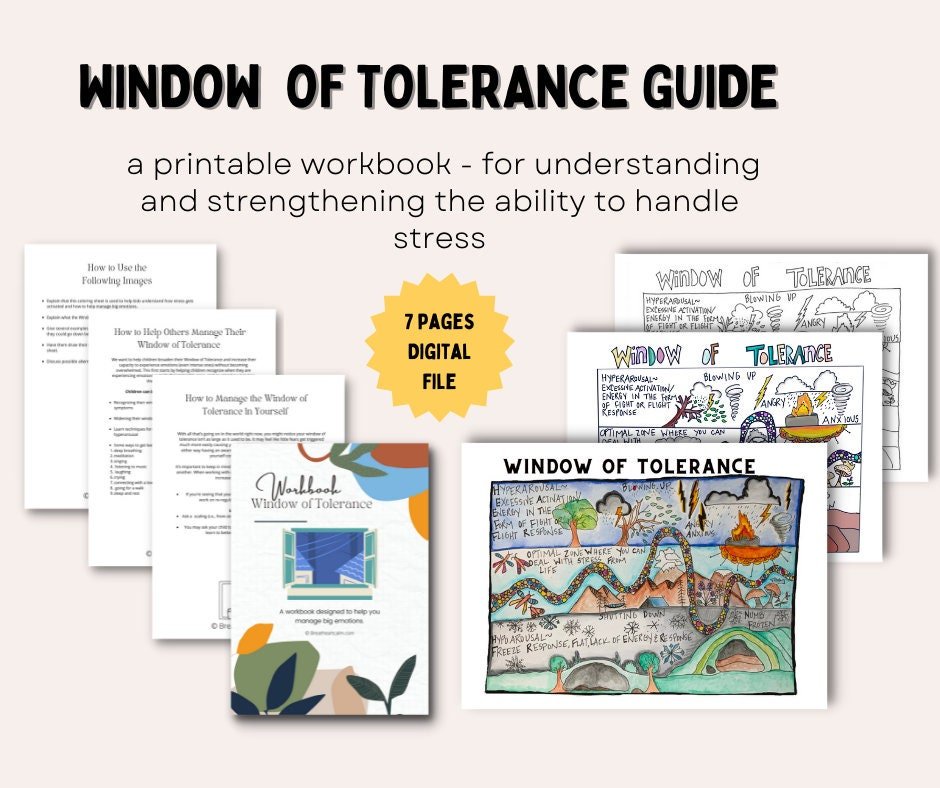 Image 1 of 5
Image 1 of 5

 Image 2 of 5
Image 2 of 5

 Image 3 of 5
Image 3 of 5

 Image 4 of 5
Image 4 of 5

 Image 5 of 5
Image 5 of 5






Guide to Window of Tolerance
Guide to Window of Tolerance| Self Regulation Skills| Manage Big Emotions Workbook| PLUS COLORING SHEET
The concept of a Window of Tolerance (WOT), was created by Dr. Dan Siegel in 1999 and is used to help explain the way the brain and the nervous system react to stress. When pushed outside this middle zone, we can either blow up like a tornado or shut down and freeze like going into a cave.
Each of us has a “window of tolerance,” or a certain level of arousal we can navigate skillfully. When we are within this window, we thrive. We are able to learn, communicate, play and relate well to ourselves and others.
When we move outside of this window, we can become hyper-aroused (too much) and hypo-aroused (too little). We have trouble registering our feelings, responding with emotions appropriate to the context, and regulating those responses in social situations. We might either suppress our emotions or respond with overly dramatic and excessive emotional outbursts.
I’m sure it’s no surprise to you that when we’re feeling overwhelmed (especially over a long period of time), our optimal middle window of tolerance gets smaller and smaller.
What is Hyperarousal?
Hyperarousal is also known as the “fight, flight, or freeze response” and is a heightened state of anxiety. It is when a child's nervous system suddenly kicks into high alert, even when danger might not be present. Clients may not feel in control over their actions when they enter this state. It can often be triggered by a perceived threat, traumatic memories, or specific emotions. It is also one of the primary symptoms of post-traumatic stress disorder (PTSD).
Middle Window of Tolerance
When we’re feeling safe, calm, and able to engage well in daily life, we are likely in our optimal zone and inside this window of tolerance.
What is Hypoarousal?
Hyperarousal is also known as the “shutdown” or “collapse” response. Like hyperarousal, it can often be triggered by feeling threatened, recounting traumatic memories, or feeling emotions associated with past trauma. Even a perceived threat can be enough to send a child into shutdown or even dissociation.
Guide to Window of Tolerance| Self Regulation Skills| Manage Big Emotions Workbook| PLUS COLORING SHEET
The concept of a Window of Tolerance (WOT), was created by Dr. Dan Siegel in 1999 and is used to help explain the way the brain and the nervous system react to stress. When pushed outside this middle zone, we can either blow up like a tornado or shut down and freeze like going into a cave.
Each of us has a “window of tolerance,” or a certain level of arousal we can navigate skillfully. When we are within this window, we thrive. We are able to learn, communicate, play and relate well to ourselves and others.
When we move outside of this window, we can become hyper-aroused (too much) and hypo-aroused (too little). We have trouble registering our feelings, responding with emotions appropriate to the context, and regulating those responses in social situations. We might either suppress our emotions or respond with overly dramatic and excessive emotional outbursts.
I’m sure it’s no surprise to you that when we’re feeling overwhelmed (especially over a long period of time), our optimal middle window of tolerance gets smaller and smaller.
What is Hyperarousal?
Hyperarousal is also known as the “fight, flight, or freeze response” and is a heightened state of anxiety. It is when a child's nervous system suddenly kicks into high alert, even when danger might not be present. Clients may not feel in control over their actions when they enter this state. It can often be triggered by a perceived threat, traumatic memories, or specific emotions. It is also one of the primary symptoms of post-traumatic stress disorder (PTSD).
Middle Window of Tolerance
When we’re feeling safe, calm, and able to engage well in daily life, we are likely in our optimal zone and inside this window of tolerance.
What is Hypoarousal?
Hyperarousal is also known as the “shutdown” or “collapse” response. Like hyperarousal, it can often be triggered by feeling threatened, recounting traumatic memories, or feeling emotions associated with past trauma. Even a perceived threat can be enough to send a child into shutdown or even dissociation.